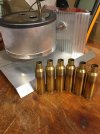How much your brass anneals is determined by the combination of temperature and time; a hotter temperature requires less time and a lower temperature requires more time. For cartridge cases, we also only want to anneal the neck and shoulder, so time becomes a potential control as longer time allows more heat to travel towards the case head. My salt bath runs at 500 degrees C, and stays within about 2 degrees throughout the process (thankyou PID, the Lee thermostat simply can't do that). I watch a second hand and count seconds to keep time consistent, and the case holder I made keeps the depth that the case is in the bath consistent. Automated might be nice, but I can do around 200 cases an hour and not be rushed, and I paid about $150 for the whole setup. Salt bath annealing is also the process used for annealing brass for scientific instruments, so I really don't worry about any lack of consistency that some have claimed. It works as long as I can pay attention and keep the time consistent.

